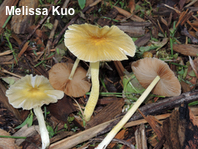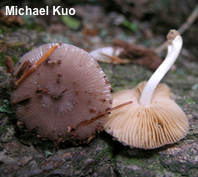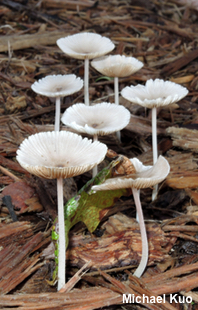| Major Groups > Gilled Mushrooms > Dark-Spored > Bolbitius |

|
[ Basidiomycota > Agaricales > Bolbitiaceae . . . ] The Genus Bolbitius by Michael Kuo, 8 November 2023 Mushrooms in this genus are generally small and flimsy. Though not as ephemeral as many coprinoid mushrooms, some of which can turn into black goo within a few summer hours, species of Bolbitius do not last long (usually a day or two, at most) and whatever interesting colors they feature in the button stage are likely to fade quickly to some version of brownish or grayish. Most species of Bolbitius develop strongly lined caps, and at maturity the gills are dull brown. Species of Bolbitius are saprobes, decomposing organic debris or wood. They are often found in urban settings in landscaping; many species are fond of woodchips, straw, compost, grassy areas, or manure. But other species are found in woods on soil, leaf litter, woody debris, or on rotting logs—and a few species are found in both woodland and urban settings. The spore print in Bolbitius is cinnamon brown—but not dark brown, purplish brown, or grayish to blackish brown. The principal competitor genera for identification are Agrocybe, Conocybe, and Pholiotina, which have similarly colored spore prints. Species of Agrocybe are often larger and thicker-fleshed, while most Conocybe and Pholiotina species have conical caps that are not usually strongly lined at maturity. However, microscopic features may need to be consulted to rule out other genera; cystidia in Agrocybe, Conocybe, and Pholiotina are distinctive and un-Bolbitius-like, and probably make the best yardstick for a quick microscopic assessment. In-depth, species-level, DNA-informed, contemporary treatments of Bolbitius are few and far between; as of this writing only one has been done, to my knowledge, and it was focused on Russian material (Malysheva et al. 2015). In that study researchers determined that distinct phylogenetic species may be hanging out within Bolbitius titubans and Bolbitius reticulatus, and called for continued research into the genus. Identification of species within Bolbitius can be fairly easy if 1) you have collected specimens in all stages of development, including young specimens in the button stage that have not yet lost their colors, and 2) you are willing to accept species groups like "Bolbitius titubans" and "Bolbitius reticulatus." Non-microscopic features used in Bolbitius identification include colors of the cap and stem, the size of the mature mushroom, and the habitat of the mushrooms. Occasionally, microscopic features (primarily spore morphology) must be consulted—and that "occasionally" turns into "always" if your collection consists only of mature, gray to brown specimens that have lost their youthful colors. Because extensive taxonomic work on Bolbitius is still needed, many species names are thrown back and forth between Europe and North America (some species have been described from other places, too), and current species concepts are often applied fairly widely. Thus the key below treats both European and North American species, with only occasional reference to the range of a given species. |
|
|
Key to 15 Bolbitius Species in Europe and North America
References Amandeep, K., N. S. Atri & K. Munruchi (2013). Diversity of species of the genus Bolbitius (Bolbitiaceae, Agaricales) collected on dung from Punjab, India. Mycosphere 4: 1053–1064. Arnolds, E. (2005). Bolbitius Fr. In Noordeloos, M. E., Th. W. Kuyper & E. C. Vellinga, Flora Agaricina Neerlandica: Critical monographs on families of agarics and boleti occurring in the Netherlands, Vol. 6. Boca Raton: Taylor & Francis, 112–119. Ferisin, G. & L. Pellizzari (2017). Bolbitius excoriatus, una nuova specie per il Friuli Venezia Guilia. Micologia e Vegetazione Mediterranea 32: 75–80. González, M. & A. P. Peman (2019). Diez especies raras o poco conocidas de Agaricales recolectadas en la Península Ibérica. Boletín de la Sociedad Micológica de Madrid 43: 81–110. Hausknecht, A. & M. Contu (2006). Bolbitius demangei in Italien. Österreichische Zeitschrift für Pilzkunde 15: 7–10. Hausknecht, A., V. Antonín & J. Polčák (2007). A new, conspicuously coloured Bolbitius species from the Czech Republic. Czech Mycology 59: 1–9. Hausknecht, A., M. Contu & I. Krisai-Greilhuber (2008). Bolbitius subvolvatus, a new species from Sardinia (Italy). Österreichische Zeitschrift für Pilzkunde 17: 1–5. Hausknecht, A., M. Contu, I. Krisai-Greilhuber, R. M. Dähncke & A. Vizzini (2010). Bolbitius excoriatus (Basidiomycota, Agaricales), a new species from Spain. Österreichische Zeitschrift für Pilzkunde 19: 121–126. Hausknecht, A. & J. Vesterholt (2018). Bolbitius Fr. In Knudsen, H. & J. Vesterholt, eds., Funga Nordica: Agaricoid, boletoid, clavarioid, cyphelloid and gastroid genera. Copenhagen: Nordsvamp, 733–735. Horak, E., G. Moreno, A. Ortega & F. Esteve-Raventós (2002). Bolbitius elegans, a striking new species from southern Spain. Persoonia 17: 615–623. Kalinina, L., E. Malysheva & T. Bulyonkova (2021). Bolbitius callistus. In Lebeuf, R. & 34 coauthors, Fungal systematics and evolution: FUSE 8. Sydowia 74: 193–249. Kaygusuz, O. (2022). First record of Bolbitius reticulatus (Agaricales: Bolbitiaceae) in Turkey, with nuclear ITS and LSU rDNA sequences data. The Journal of Fungus 13: 1–7. Malysheva, E. F., V. F. Malysheva & T. Y. Svetasheva (2015). Molecular phylogeny and taxonomic revision of the genus Bolbitius (Bolbitiaceae, Agaricales) in Russia. Mycological Progress 14: 64. Tóth, A., A. Hausknecht, I. Krisai-Greilhuber, T. Papp, C. Vágvölgyi & L. G. Nagy (2013). Iteratively refined guide trees help improving alignment and phylogenetic inference in the mushroom family Bolbitiaceae. PLoS ONE 8: e56143. Usman, M., A. N. Awan, N. Yousaf, G. Murtaza, M. Hanif & A. N. Khalid (2022). First records of Bolbitius coprophilus (Agaricales, Bolbitiaceae) from Pakistan. Check List 18: 525–533. Watling, R. (1975). Observations on the Bolbitiaceae 11: A species of Bolbitius with ornamented basidiospores. Notes from the Royal Botanic Garden Edinburgh 34: 241–243 Watling, R. (1982). Bolbitius Fries. In Watling, R., British Fungus Flora, Agarics and Boleti, 3: Bolbitiaceae: Agrocybe, Bolbitius & Conocybe. Edinburgh: Her Majesty's Stationery Office, 31–38. Watling, R. & Miller, O. K. Jr. (1987). Observations on the Bolbitiaceae—30. Agaricus callistus Peck. Mycologia 79: 310–313. This site contains no information about the edibility or toxicity of mushrooms. Cite this page as: Kuo, M. (2023, November). The genus Bolbitius. Retrieved from the MushroomExpert.Com Web site: http://www.mushroomexpert.com/bolbitius.html © MushroomExpert.Com |



